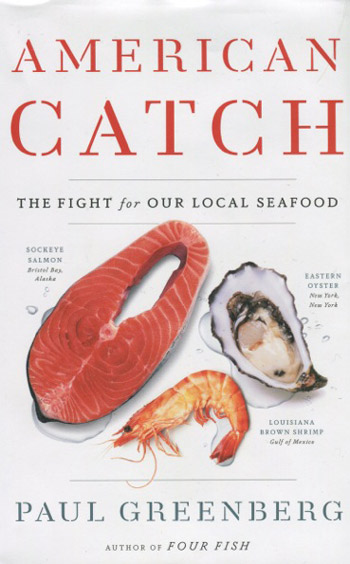B O O K R E V I E W
Why Are We Eating
This Imported Stuff?

American Catch
The Fight for Our Local Seafood
by Paul Greenberg
The Penguin Press, New York
306 pages; $26.95 US
The subtitle of this book is The Fight for Our Local Seafood.
While Greenberg is on his game with the management and politics of how we got to where we are on seafood as a nation, calling the current response to the near disappearance of local seafood sources a fight is a bit of an exaggeration, at least when compared with the momentum and power behind international corporate and government efforts in the opposite direction. The local land foods movement has grown, but the nascent local seafood effort can hardly be called a fight yet. “We are too confused or too preoccupied to widen the circle of localness to include the local ocean,” Greenberg writes.
Instead of the good fish we catch here, we are largely offered imported fish products from unknown sources. Greenberg's long suit is shrimp, America's most consumed “seafood.” Most imported shrimp is neither seafood nor food, at least as defined by FDA standards. Imported shrimp, more often than not, is raised in shoreside ponds, not the sea, which are notoriously contaminated with waste, chemicals and antibiotics.
Greenberg’s 43 pages of research references are alone worth the price of the book. He cites a 2012 U.S. beef production figure of 25.91 billion pounds. The U.S. consumed 25.8 billion pounds of that beef. Meanwhile, in the last 50 years, U.S. imports of seafood have risen 1,476 percent, while 33 percent of the American catch is being exported.
“Fear of pollution, greed-driven real estate development in our estuaries, and worry about domestic overfishing have compelled us to try to fix our seafood shortcomings through foreign imports. Overfishing has greatly decreased in American waters. But American fishermen are going extinct,” writes Greenberg.
American Catch is wide-ranging and well-written, with excellent research. In many ways, Greenberg builds on the work of Paul Molyneaux, who wrote about the consolidation of American fishing and industrialization of aquaculture in A Doryman’s Day and Swimming in Circles. Molyneaux tracked the evolution of the problems Greenberg describes in detail, and how these changes have played out for American seafood consumers. Standing across the road from the ocean, Americans cannot buy fresh seafood at the supermarket behind them.
One of the best-managed fisheries in the world, the Maine lobster fishery, is searching for ways to export Maine lobster to raise the market price. The lobster marketing group could look at reversing the political deals on shrimp imports that were made in Washington, D.C. – deals which have helped undermine the price of lobster.
American Catch is focused on Eastern oysters, shrimp and sockeye salmon. Greenberg writes about the history of these fisheries, how they declined, the importance of each and how a few are seeing some recovery. Their importance goes well beyond their market share. The importance is ecologically based, and we humans are therefore in that equation. American Catch is not a doomsday tract, but Greenberg is direct in stating that a lot is going to have to change in the way humans manage, consume and understand sea animals and the oceans, if this vital resource is going to remain renewable.
